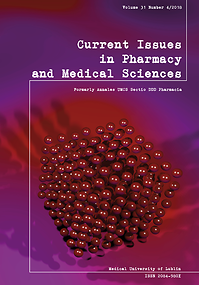Phenolic compounds of herbal infusions obtained from some species of the Lamiaceae family
DOI:
https://doi.org/10.1515/cipms-2018-0036Keywords:
Dracocephalum moldavica, Ocimum americanum, Satureja hortensis, phenolic compounds, HPLC, spectrophotometryAbstract
The present investigation was to estimate the total phenolic content and composition of flavonoids and hydroxycinnamic acids in herbal infusions obtained from aerial parts of threeLamiaceaespecies (Dracocephalum moldavica, Ocimum americanumandSatureja hortensis). The total phenolic content of herbal infusions was determined using a spectrophotometric method, whereas the individual phenolics were assessed by high-performance liquid chromatography (HPLC). The HPLC method was developed and validated. The total phenolic content was measured by applying the Folin-Ciocalteu method with reference to gallic acid. Results were in the range from 29.39 to 65.38 mg estimated as gallic acid equivalents per gram of dry herb. The phenolic profile was, in turn, analysed by HPLC and consisted of gallic acid, hydroxycinnamic acids (caffeic, chlorogenic, ferulic, and rosmarinic) and flavonoids (rutin, hyperoside, quercitrin, quercetin, apigenin, apigenin-7-glucoside and catechin) in different concentrations. Rosmarinic acid was the predominant component among the hydroxycinnamic acids in herbal infusions of all three plants. This was found to be in the range of 3.64 to 5.28 mg per gram of dry herb. Apigenin-7-glucoside, quercitrin and hyperoside were the prevailing flavonoid components of the infusions.
References
1. The Plant List: http://www.theplantlist.org.
2. Carovic-Stanko K, Petek M, Grdiša M, et al. Medicinal plants of the family Lamiaceae as functional foods – a review. Czech J. Food Sci. 2016;34 (5):377-90.
3. Gougoulias N, Mashev N. Antioxidant activity and polyphenols content of some herbal teas of Lamiaceae family from Greece and Bulgaria. Oxid Commun. 2015;38(1):25-34.
4. Kakasy AZ. New phytochemical data on Dracocephalum species/ Theses of the PhD dissertation. Budapest, 2006:14.
5. Shanaida M, Ivanusa I, Κernychna I. Phytochemical analysis of secondary metabolites of Satureja hortensis L. Int J Pharm Pharm Sci. 2017;9(2):315-8.
6. Vlase L, Benedec D, Hanganu D, Damian G, Csillag I, Sevastre B, et al. Evaluation of antioxidant and antimicrobial activities and phenolic profile for Hyssopus officinalis, Ocimum basilicum and Teucrium chamaedrys. Molecules. 2014;19:5490-507.
7. Cioroi M, Dumitriu D. Studies on total polyphenols content andantioxidant activity of aqueous extracts from selected Lamiaceae species. Annals of the University Dunarea de Jos of Galati. Fascicle VI – Food Technology. 2009;34(1):42.
8. Crozier A, Clifford M, Ashihara H. Plant secondary metabolites: occurrence, structure and role in the human diet. Oxford, Blackwell Publishing Ltd;2006:384.
9. Hakkim FL, Arivazhagan G, Boopathy R. Antioxidant property
10. of selected Ocimum species and their secondary metabolite content.
11. J Med Plant Res. 2008;2(9):250-7.
12. Katalinic V, Milos M, Kulisic T, Jucic M. Screening of 70 medicinal plant extracts for antioxidant capacity and total phenols. Food Chemistry. 2006;94(4):550-7.
13. Moraes-de-Souza RA. Antioxidant activity and phenolic composition of herbal infusions consumed in Brazil. CYTA – J Food. 2008;6:41-7.
14. Sunil K. The importance of antioxidant and their role in pharma-
15. ceutial science – a review. Asian J Res Chem Pharm Sci. 2014;1(1): 27-44.
16. Karau GM, Njagi ENM, Machocho AK, Wangai LN, Nthinga MJ. Chemical composition and in vitro antioxidant activities of Ocimum americanum. Advances in Analytical Chemistry. 2015;5(2):42-9.
17. Yesiloglu Y, Sit L, Kilic I. In vitro antioxidant activity and total phenolic content of various extracts of Satureja hortensis L. collected from Turkey. Asian J Chem. 2013;25(15):8311-6.
18. Chrpova D, Kouřimská L, Gordon MH, Heřmanová V, Roubíčková I, Panek J. Antioxidant activity of selected phenols and herbs used in diets for medical conditions. Czech J Food Sci. 2010;28:317-25.
19. Vieira RF, Grayer RJ, Paton AJ. Chemical profiling of Ocimum americanum using external flavonoids. Phytochem. 2003;63(5): 555-67.
20. Rusaczonek A, Swiderski F, Waszkiewicz-Robak B. Antioxidant properties of tea and herbal infusions. Pol J Food Nutr Sci. 2010;60(1):33-5.
21. Khomdram S, Potsangbam K. Polyphenolic сompounds and free radical scavenging activity in eight Lamiaceae herbs of Manipur. Not Sci Biol. 2011;3(2):108-13.
22. Derzhavnyi reiestr lіkarskyh zasobiv Ukrainy (2018) [Elektronnyi resurs]. Rezhym dostupu: http://www.drlz.com.ua.
23. European Pharmacopoeia: 8th edition. 8.0-8.2, 2014.
24. Singleton VL, Rossi JA. Colorimetry of total phenolics with phosphomolybdic-phosphotungstic acid reagents. Am J Enol Vitic. 1965;16:144-58.
25. Marinova D, Ribarova F, Atanassova M. Total phenolics and total flavonoids in Bulgarian fruits and vegetables. J. of the Univ. of Chem. Cech. 2005;40(3):255-60.
26. Golembiovska O. Simultaneous determination of flavonoids and phenolic acids in different parts of Prunella vulgaris L. by HPLC-DAD. Int J Pharmacogn Phytochem. 2014;29(1):1248-55.
27. Shabir GA. Validation of high-performance liquid chromatography methods for pharmaceutical analysis. Undestanding the differences and similarities between validation requirements. J. of Chromatogr A.
28. 2003;987:57-66.
29. Staszek D, Orlowska M. Marker fingerprints originating from TLS and HPLC for selected plants from the Lamiaceae family. J Liq Chromatogr Relat Technol. 2013;36:2463-75.
30. Petersen M, Simmonds M. Rosmarinic acid. Phytochem. 2003; 62(2):121-5.
31. Shanaida M, Kernychna І, Shanaida Yu. Chromatographic analysis of organic acids, amino acids, and sugars in Ocimum americanum L.
32. Acta Poloniae Pharmaceutica – Drug Research. 2017;74(2):729-32
Downloads
Published
Issue
Section
License
Copyright (c) 2019 Autors

This work is licensed under a Creative Commons Attribution-NonCommercial-NoDerivatives 3.0 Unported License.


